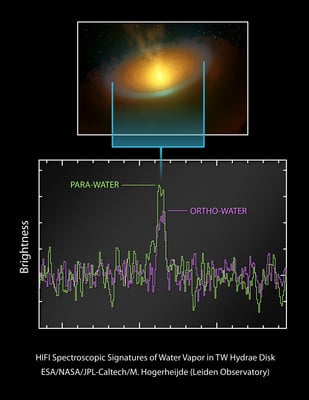[/caption]
There's enough water in a planet-forming disk around a distant star to fill several thousand Earth oceans, according to new observations with the Herschel space observatory. Astronomers have found evidence of water vapor originating from ice on dust grains in the disc around a young star, TW Hydrae. The star is between 5-10 million years old, so is in its final stages of formation.
"The detection of water sticking to dust grains throughout the disc would be similar to events in our own Solar System's evolution, where over millions of years, similar dust grains then coalesced to form comets," said Michiel Hogerheijde of Leiden University in the Netherlands, who led the study. "These comets we believe became a contributing source of water for the planets."
Herschel has found water around other stars, such as a
n old red giant star CW Leonis
, and other telescopes like Spitzer have also observed
abundant water in nascent planet forming regions
around other stars.
But scientists say this latest research from Herschel breaks new ground in understanding water's role in planet-forming discs and gives scientists a new testing ground for looking at how water came to our own planet.
"With Herschel we can follow the trail of water through all the steps of star and planet formation," said Göran Pilbratt, Herschel Project Scientist at ESA.
Scientists think the water vapor signature is produced when the ice coated dust grains are warmed by interstellar UV radiation.
Read more on this discovery at the
ESA Herschel website.
 Universe Today
Universe Today
